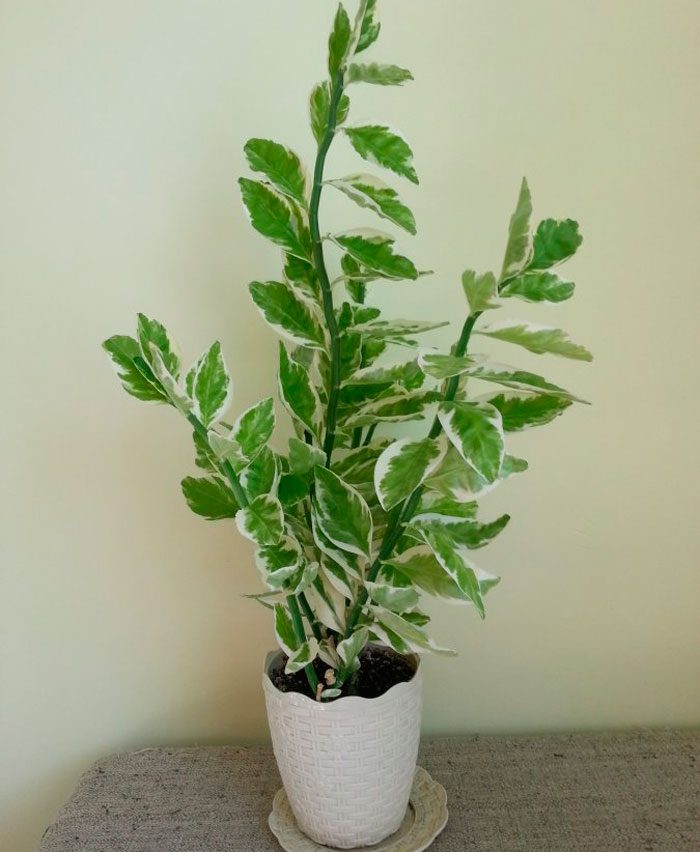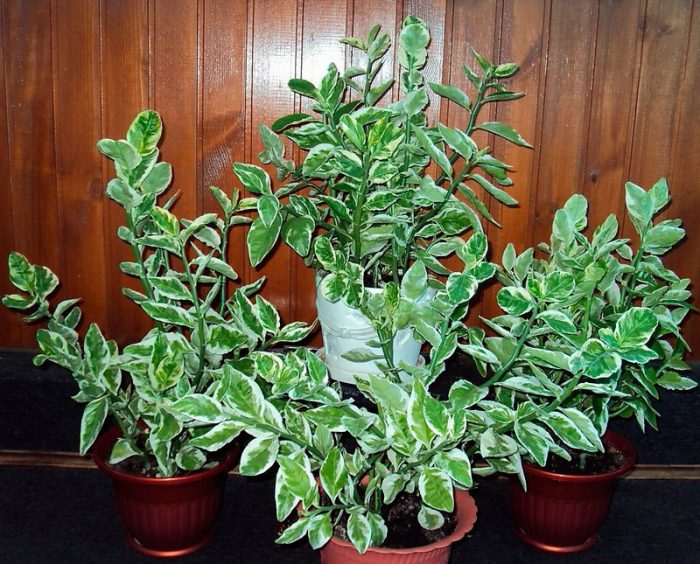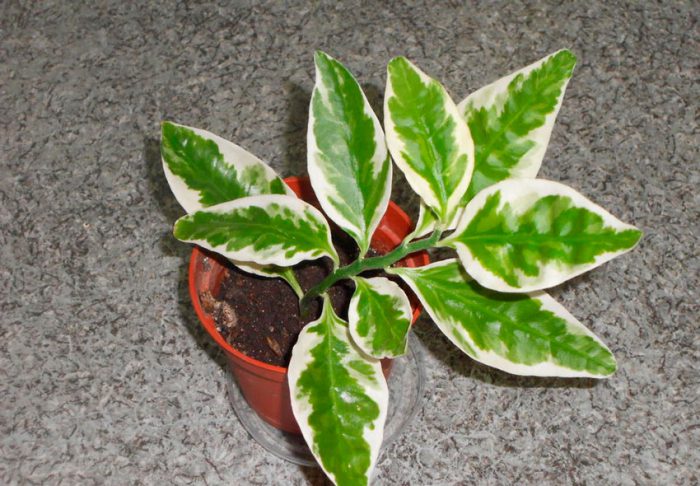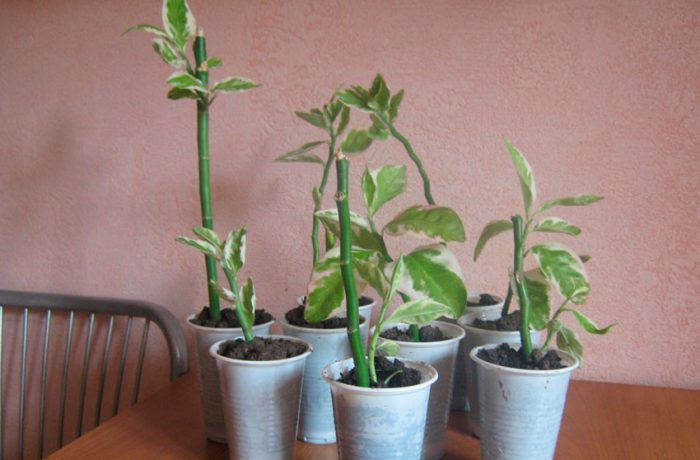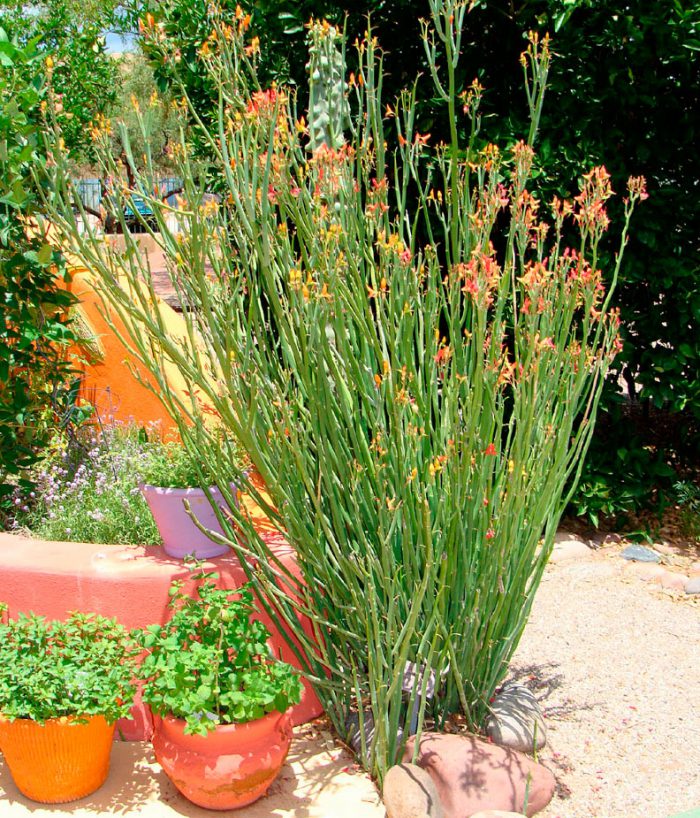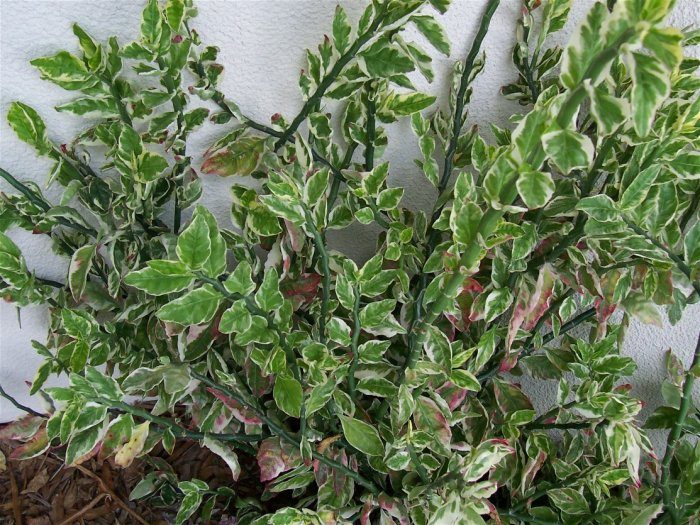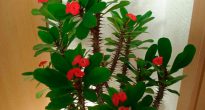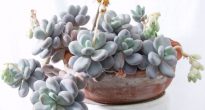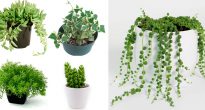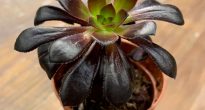A plant like pedilanthus (Pedilanthus) belongs to a fairly large family of Euphorbiaceae. It is a highly branching shrub. In nature, such a plant can be found in Central, North, and South America.
Different species can grow in places that differ significantly from each other in natural and climatic conditions. In this regard, such plants outwardly are quite different from each other. So, for example, Titimaloid Pedilanthus is a compact shrub with fairly dense foliage, and it prefers to grow in dry tropical forests. In the same forests, pedilanthus spur also grows, but outwardly it may look like a small tree. And such a succulent as large-fruited pedilanthus has almost no foliage, but it has water-storing tissues. In humid tropical forests, you can find the finca pedilanthus.
This genus was named pedilanthus because of the appearance of the flowers. So, translated from Greek “pedilon” means “shoe”, and “anthos” means “flower”. A characteristic feature of this kind of succulents are spectacular flowers. Because of them, that plant is so popular with flower growers.
Home care for pedilanthus
Illumination
Such a plant needs bright lighting, but the light must always be diffused. It should be protected from direct sunlight. In the summer, it is recommended to move the flower outside. A suitable place for it should be protected from rain, as well as from direct sunlight.
In winter, the lighting should also be very bright. To achieve the desired level, experts advise to provide supplementary lighting with special phytolamps.
Temperature regime
In the spring and summer, the temperature should be kept at about 25 degrees. At the same time, the plant needs very frequent ventilation of the room where it is located. With the onset of autumn, the pedilanthus should be placed in a cooler place with a temperature of 14 to 18 degrees. With this content, the foliage will not be too strong.
Humidity
There is no need to maintain a special humidity regime in the room.
How to water
In the summer, the substrate in the container should be slightly moistened (not wet) at all times. The plant reacts to overdrying the earthen coma by dumping foliage. Water should be moderate in winter.It should be borne in mind that such a succulent is equally harmful to both drying out of the soil and stagnation of liquid in it.
In order to ensure the most suitable watering regime, one should focus on the state of the leaves. So, it is necessary to water the pedilanthus only after the leaves begin to lose their turgor (drop a little). If the watering is too scanty, then all the leaves can fly around.
Top dressing
Top dressing is carried out in the spring-autumn period 1 time in 4 weeks. For this, fertilizers are used for succulents with a low nitrogen content. If there is too much nitrogen in the soil, this can cause the development of rot. In the autumn-winter period, it is impossible to feed the plant.
Earth mix
Suitable soil should be light, neutral and permeable to water and air. To prepare the soil mixture, combine turf and leaf land with sand in a ratio of 1: 2: 2.
Transplant features
The transplant is carried out in the spring and only if necessary, for example, the root system has become cramped in the container. It should be borne in mind that the root system of such a flower is relatively small. The new container should have a diameter approximately equal to its height. Do not forget to make a good drainage layer of expanded clay at the bottom of the pot during transplantation. This will help to avoid stagnant water and soil acidification.
Reproduction methods
As a rule, apical cuttings are used for propagation, but sometimes seeds are also used for this purpose.
Cuttings should be done in spring or summer. To do this, cut off the upper parts of the stems (length from 8 to 10 centimeters), then they are placed in lukewarm water in order for the juice to flow out. After they are taken out of the water and left in the open air for drying. Depending on the size of such a cutting, its drying can last from 1 to 2 days, and maybe longer. For rooting, almost dry perlite or sand is used, and the required temperature should be from 20 to 25 degrees. You should not cover the cutting planted for rooting from above, as this can contribute to the rapid development of rot. During rooting, it is recommended to remove the leaves from the bottom of the cuttings in order to avoid rotting. Full rooting will occur after 2–3 weeks.
Caution! This flower has a very pungent juice. In this regard, when handling it, do not forget to be careful and use rubber gloves.
Pests and diseases
- Fungal disease - darkening of the end of the cutting and its rotting. Get rid of infected cuttings.
- Aphid - on young leaves and on the upper part of the shoots, you can see very small pests of green color, leaf plates stop growing and curl. Shower the plant or treat it with an appropriate insecticide. The affected leaves must be removed.
- Spider mite - the foliage becomes lethargic and changes its color to yellow, a web appears on the seamy side. Treat with acaricide and try to keep the air humidity always high.
- Mealybug - there are whitish, cotton-like formations on the shoots and in the leaf axils. The flower stops growing. Remove insects with cotton wool swabs moistened with alcohol.
- Whitefly - the leaves become yellow and sticky. If you touch the flower, you can see how small whitish midges fly from it. Give the plant a shower. If infestation is severe, treat with insecticide.
Possible difficulties
- Leaves fly around - improper watering, little or much light.
- In winter, the stems stretch out - the room is not cool enough, poor lighting.
- Elongation of the leaf petiole Is the norm.
- Yellowing and drying of the tips of the leaf plates - low air humidity, intense lighting.
- Small green leaves grow instead of large, variegated ones, and they soon fly around - poor lighting.
- The leaves turn green, the development of their petioles stops - high nitrogen content in the soil.
- The plant sheds all foliage - a sharp drop in air temperature during ventilation in winter. In the event that the shoots are not frozen and the green color remains, then the flower will not die. Otherwise, cut off the dead parts of the flower and wait for new shoots to grow.
Video review
Main types
Large pedilanthus (Pedilanthus macrocarpus)
Such succulent plants, which have a bushy appearance, do not have foliage. They have water-storing greenish-gray round shoots. Moreover, some of the shoots are quite capable of changing their shape to a flattened one.
Pedilanthus tithymaloides
Such a bushy succulent has a spectacular and unusual flower shape. So, they look like a fancy bird or shoe. And this kind also has variegated foliage that is very bright and unusual. So, it can be painted from dark green with whitish blotches in the center to a white edge.
Variety "Variegatus" has variegated, wavy leaves with short petioles. At the same time, there is a porcelain-white border on the leaf plate, which turns into a bright red or pinkish color. The fleshy green shoot has a zigzag shape because it changes direction when a new leaf is grown. Blooms in the second half of the autumn period. The flowers are in the upper part of the shoots, while the inflorescences formed by them have glossy covering leaves of red color.
Pedilanthus finkii
This species prefers to grow in moist, tall-trunked tropical forests, while it is found in the underbrush. This bushy succulent needs loose and light soil.

